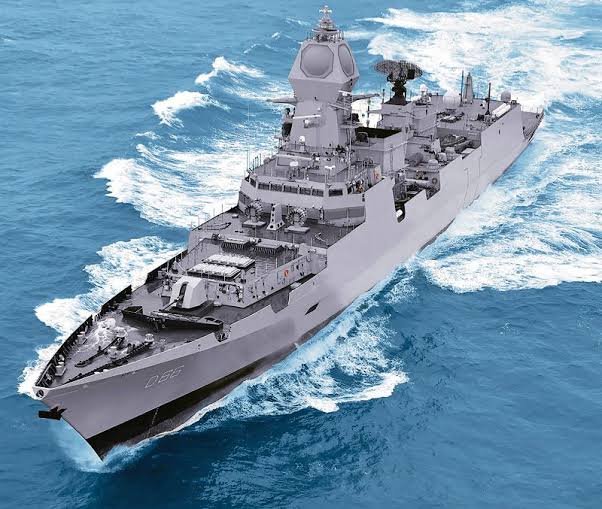India Needs To Do A Lot More To Realise Its Natural Maritime Potential

by C Uday Bhaskar
THE commissioning of two naval platforms in Mumbai over the past week — the guided-missile destroyer INS Visakhapatnam and the diesel submarine INS Vela is a significant punctuation in India’s warship building effort and is to be welcomed.
The 7,400-tonne destroyer, with some state-of-the-art features, is a tribute to the professional acumen of India’s indigenous warship design capabilities and the submarine, built with French collaboration, will enhance a strategic niche competence.
The Maritime Capability Perspective Plan that had envisioned a force of a 200-ship Navy by 2027 has now been trimmed to 170 platforms.
This modest addition to India’s depleted naval inventory must be seen against the backdrop of China. In the period that India was commissioning naval platforms, media reports indicated that China was building a secret military facility in the UAE port of Khalifa and that this was being done furtively without the knowledge of the host country.
The Chinese footprint in the Indian Ocean Region (IOR) is steadily increasing. Beijing acquired a military base at Djibouti in the Horn of Africa in 2017 and is heavily invested in ports in Pakistan and Sri Lanka. In essence, from Galwan to Gwadar, the military challenge from China is an abiding factor for the Indian security planner.
Given the Covid-induced fiscal constraints that India is coping with, the Navy (often termed the Cinderella service since it receives the least funding support among the three armed forces) has had to trim its acquisition plans in a marked manner. The Maritime Capability Perspective Plan (MCPP) that had envisioned a force of a 200-ship Navy by 2027 has now been trimmed to 170 platforms.
In contrast, the US think tank, Centre for Strategic and International Studies (CSIS) has estimated that if the current pace of warship-building is sustained by Beijing, the PLA navy could have 425 platforms by 2030. India may not seek or aspire for quantitative military equivalence with its northern neighbour, given that China is benchmarking itself apropos the US as a competitor/adversary. However, one statistic by way of the time taken to build a warship in India merits scrutiny.
Construction on the destroyer Visakhapatnam began in October 2013 and the ship was launched in April 2015. Finally, after eight years from commencement, the warship was commissioned in late 2021.
In comparison, in the past five years, Beijing has added between 14 and 22 platforms annually to its navy. A nation that aspires to acquire a credible trans-border maritime profile has to acquire a certain level of proven ship-design and nimble ship-building capability. India has been found wanting in the latter aspect.
While India has the potential to be a maritime power that would enhance its composite national power and improve the socio-economic indicators of its sizeable demography — it lacks the requisite strategic perspicacity and national resolve.
Naval power is only one attribute of a nation’s holistic maritime capability. Paradoxically, despite its favourable geography, wherein the Indian peninsula majestically dominates the Indian Ocean, allowing it to harness connectivity for trade and monitor the natural choke-points to ensure security — even 70-plus years after Independence — Delhi remains unable to realise its natural maritime potential.
To his credit, PM Modi accorded the maritime domain a degree of political visibility when he coined the acronym SAGAR (security and growth for all in the region) for the IOR in 2015. However, in the intervening seven years there has not been any substantive enhancement of national maritime capability.
In relation to hard naval power, the budgetary allocation for the silent service that had reached upwards of 18 per cent of the overall defence budget in FY 2012-13 has now shrunk to less than 14 per cent. Cost and time overruns in warship-building have become a tenacious constraint — barring a private sector exception. Indian ports and harbours are operating well below the globally accepted median of efficiency. It is a matter of shame that India, despite its economic and global trade status, does not have a single port on the list of global 20 major ports.
Thus, while the Defence Minister Rajnath Singh asserted at the commissioning ceremony of INS Visakhapatnam that ‘We have every opportunity to build India into an indigenous ship-building hub’, the ground reality does not correspond with the political rhetoric.
While it is gratifying that the Navy has placed orders with Indian shipyards for 39 of the 41 ships being built and the initiative is being heralded as a testament to the commitment to ‘Atmanirbhar Bharat’, a reality check is more granular. The equipment on INS Visakhapatnam is illustrative. While the cost of the ship is disaggregated as being 75 per cent indigenous — or paid for in Indian rupees — the inventory that makes the platform a fighting unit is largely imported. The main gun is of Italian origin, the Barak missile and fire-control radar are from Israel and the gas turbines are from Ukraine. These details are glossed over and a more rosy picture is sought to be projected apropos of indigenisation.
While no nation produces every bit of military equipment indigenously, a certain core competence in ordnance and propulsion is a must. India is yet to acquire that level of ‘Atmanirbharta’, though the success in areas like sonars and electronic warfare is commendable.
Accreting tangible maritime/naval capability is a long lead-time process and needs sustained policy support and assured funding. This has remained elusive. Navy Chief Admiral Karambir Singh, who lays down office at the end of November, has a pithy yet persuasive policy prescription: contain China, punish Pakistan, reassure Russia, invigorate the IOR and upscale ties with the US.
This is a template that needs to be internalised by the Indian higher defence establishment in the decades ahead as Delhi seeks to acquire an appropriate level of relevance in the IOR.




